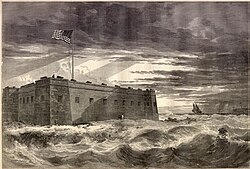Top Qs
Timeline
Chat
Perspective
Battle of Santa Rosa Island
1861 battle of the American Civil War From Wikipedia, the free encyclopedia
Remove ads
The Battle of Santa Rosa Island (October 9, 1861) was an unsuccessful Confederate attempt to take Union-held Fort Pickens on Santa Rosa Island, Florida.


Remove ads
Background
Santa Rosa Island is a 40-mile barrier island in the U.S. state of Florida, thirty miles from the Alabama state border. At the western end stands Fort Pickens, which in the first week of January 1861 had a garrison of only one company, Company G of the 1st Regiment, US Artillery. The fort was commanded by Major John H. Winder, a secessionist who would have likely turned the fort over to the rebel government. Instead, Winder and his senior lieutenant were absent from the fort and so the garrison was commanded by Lieutenant Adam J. Slemmer. Slemmer immediately began to collect armaments from the nearby military posts and prepared to hold out against the growing rebellion.[a][1]
By the fall of 1861, it was reinforced by more men from the 1st, as well as the 2nd and 5th U. S. artillery, and the 3rd U.S. Infantry, under command of Col. Harvey Brown, of the 5th artillery. The 6th New York Volunteer Infantry, commanded by Col. William Wilson, was encamped outside the fort, a short distance east of it.[2]
Remove ads
Battle
Summarize
Perspective
After midnight on October 9, Brig. Gen. Richard Anderson crossed from the mainland to Santa Rosa Island with 1,200 men in two small steamers to surprise the Union troops at Camp Brown and if possible capture Fort Pickens. He landed on the north beach about four miles east of Fort Pickens and divided his command into three columns. After proceeding about three miles, the Confederates surprised the 6th Regiment, New York Volunteers, in Camp Brown and routed the regiment. Gen. Anderson then adopted a defensive stance to entice the Federals to leave the fort and attack. Receiving reinforcements, Col. Harvey Brown sallied against the Confederates, who reembarked and returned to the mainland.
The Union loss was 14 killed, 29 wounded and 24 captured or missing. General Braxton Bragg and Lieutenant Hamel, commanding the Confederate forces at Pensacola, reported their loss as "30 or 40 killed and wounded," but an undocumented Confederate newspaper, found by Lieut. Seeley a few days after the occurrence, gave the total casualties as 175. This claim was likely an exaggeration. Maj. Israel Vogdes, of the 1st artillery, was captured, and on the Confederate side Gen. Anderson was severely wounded. The camp of the 6th N.Y., which was the main objective of the raid, was largely destroyed, meaning the raid could be deemed a success, but were ultimately repulsed off the island and accepted defeat. on November 22 and 23, the US troops across the bay fired 5,000 devastating rounds of artillery, destroying Fort McRee and Pensacola Navy Yard.
Fort Pickens and the battle site are preserved within the Gulf Islands National Seashore.[3]
Remove ads
Order of battle
Summarize
Perspective
This section needs additional citations for verification. (August 2007) |
Union Forces
Department of Florida: Col. Harvey Brown
- 6th New York Zouave Infantry, Col. William Wilson[4]
- Company C – Captain R. H. Hazeltine
- Company D – Captain Duffy
- Company F – Lieutenant Jacob Silloway
- Company H – Captain Charles E. Heuberer
- Company K – Captain H.L. Hoelzle[5]
- Vodges' Command – Major Israel Vogdes (c), Capt. John McL. Hildt
- Company A, 1st Artillery – Lieutenant Frank E. Taylor
- Company E, 3rd Infantry – Captain John McL. Hildt
- Company G, 6th New York Zouave Infantry – Captain James H. Dobie
- Arnold’s Command – Major Lewis Golding Arnold
- Company C, 3rd Infantry – Lieutenant Alexander Shipley
- Company H, 2nd Artillery – Captain James M. Robertson
Confederate Forces
Brig. Gen. Richard Heron Anderson
- Demolition Team – Lieutenant James H. Hallonquist
- 1st Battalion – Colonel James R. Chalmers
- Detachment, 10th Mississippi Infantry
- Detachment, 1st Alabama Infantry
- 2nd Battalion – Colonel J. Patton Anderson
- 3 Companies, 7th Alabama Infantry
- 2 Companies, 1st Louisiana Infantry (Regulars)
- 2 Companies, 1st Florida Infantry
- 3rd Battalion – Colonel John K. Jackson
- Detachment, 5th Georgia Infantry
- Detachment, Georgia Infantry Battalion
- Artillery
- Homer’s Artillery Company – Lieutenant Hollonquist
- Confederate Naval Forces
- CSS Neaffie
Aftermath
New River County, Florida was renamed Bradford County in December of 1861 after Confederate Captain Richard Bradford who was killed in the battle, and was the first officer from Florida killed during the Civil War.[6]
See also
- History of Pensacola, Florida
- The Library of Congress Prints and Photographs Division (The Battle of Santa Rosa Island)
Notes
Citations
Wikiwand - on
Seamless Wikipedia browsing. On steroids.
Remove ads

